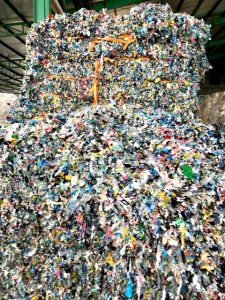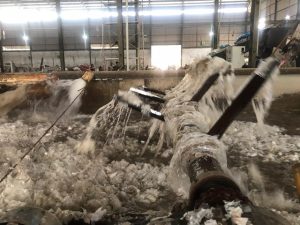By Bob Grace & Doug Woodring

Various key steps are needed to unlock the full potential of recycling and the advent of truly circular economies for plastic. So states the Ocean Recovery Alliance, a Hong Kong-based non-governmental organization (NGO), in its recently published report called “Towards Circular Plastics”.
Plastic pollution remains one of the most pressing environmental challenges of our time. The study provides a critical assessment of how recycling technologies—particularly mechanical and chemical recycling—can help to address the plastic pollution crisis by reducing mismanaged plastic waste. This is particularly vital as the United Nations Plastic Treaty negotiations enter their final stages with the INC-5.2 meeting in Geneva in August.
These steps encompass policy support, clean legislative roadmaps, infrastructure investment, and cross-sector collaboration, among other measures.
The COP17 for the Basel, Rotterdam and Stockholm Conventions in Geneva earlier this month served to remind member state delegates that the Basel Convention and the UN Plastic Treaty (in whatever format its outcome delivers), must be aligned to provide the maximum impact and efficiency in reducing plastic pollution. Countries are beginning to devise and implement new Extended Producer Responsibility laws, and recycled content mandates (i.e., the auto industry’s needs to meet the EU’s minimums by 2032). In doing so, they must facilitate significantly new supply chains for the capture and recovery of plastic feedstock for recycling and they must do so legally, and with trusted mechanisms that did not always exist even five years ago.
The Ocean Recovery Alliance report states that transparency, tracking, verification of materials, and a standardized means for pre-approval of buyers and sellers would mean that countries can engage in cross-border trade of plastic feedstock, which then creates a global circular economy.
The Plastic Waste Challenge

Some 40 million tons of plastic packaging and textile waste are currently mismanaged annually, leading to severe environmental pollution. The report highlights that systemic solutions, including policies to curb unnecessary plastic production, are paramount. However, scaling recycling technologies offers a complementary pathway to mitigate plastic leakage.
Mechanical recycling is effective for clean, single-polymer plastics, while chemical recycling can process complex or contaminated materials, such as mixed-fiber textiles. Together, these technologies can manage both easy-to-recycle and difficult-to-recycle waste, particularly in regions with high mismanagement rates. As no one-size-fits-all approach, the world should be agnostic to “recycling” technologies, as long as they are undertaken with the proper environmental standards.
Discover Material Selection with Prospector Premium, learn more here!
Redefining Recycling

In discussing recycling, it is first worth reconsidering its actual definition, as some claim that “downcycling” is not meaningful, nor actually considered “recycling” in the first place. In fact, in many cases it is difficult to turn one product back into the same product again, due to variations in material, quality and performance. This does not mean we should not circulate that material into something else valuable. “Recycling,” therefore, could be defined as the process that creates valuable second-life options for plastic (or multiple after-lives), other than incineration or for energy. Options could include building and paving materials, as well as other long-term products or infrastructure that are already technologically available.
Some secondary uses of plastic last tens or hundreds of times longer than the original product or package, can make the new products lighter and stronger, and can be sold for more than the original product, even though the original properties and material may be blended with others. The main objective is to create a circular economy with materials used multiple times, regardless of their formats in their new roles, and to avoid landfills, dumping and burning.
We should remember that marketing and branding are key factors in the “valuation” of a product, which most of us do not discuss. A good analogy here would be comparing the value of a product with recycled content, to the value of a high-priced luxury branded bag, which in reality, may not have material inputs that equate to the value at which that bag is sold, but has had a very high level of marketing and branding to support its perceived value.
Focusing On What Could Be

Ocean Recovery Alliance created the “Towards Circular Plastics” report to show stakeholders from all countries the gross volumes of plastic pollution that could be remediated if recycling and a global circular economy (which means the trade of verified feedstock) were facilitated. Not many have had these numbers in the past, and on the contrary, most have heard that less than 10 percent of plastic actually gets recycled. This puts a negative perception and low level of trust on what is actually the biggest lever for plastic pollution reduction, other than incineration (which most do not like).
There has been a lot of focus on reduce, reuse and alternative materials within the UN Plastic Treaty negotiations. But in a 2022 study, Systemiq showed that –– even in a best-case scenario –– such efforts would reduce plastic pollution by only an estimated 30 percent by 2040. It is critical, therefore, notes the Ocean Recovery Alliance, “that within the UN Plastic Treaty framework, we focus on the remaining 70 percent, or more, of plastic pollution that will continue to be produced, and on how to facilitate its circularity through recycling, vs. landfills and incineration.”
Accelerate your ESG management and performance no matter where you are on your journey, learn more here!
“Towards Circular Plastics” highlights four scenarios to estimate the impact of remediation, and how chemical recycling (often known as advanced recycling), can contribute to plastic pollution reduction by 2040. This would be complementary, and parallel, to the growth of mechanical recycling at the same time. These scenarios emphasize the importance of timely policy action that supports infrastructure development. Much of this can come from the private sector, thereby reducing some burden on the financing needs for capacity building from governments, which the UN Plastic Treaty delegates should also understand.
Four Possible Paths Forward
- Business-as-usual (BAU): Marginal recycling growth and no policy support for chemical recycling would leave 75 million tons of difficult-to-recycle plastic feedstock unaddressed, including 31 million tons of mismanaged waste.
- Delayed policy support (until 2030): Slower adoption of chemical recycling risks missing opportunities to reduce waste.
- Early policy endorsement: Strategic plant locations and infrastructure investments, particularly in Asia and Africa, could significantly boost recycling capacity.
- Integrated system: Combining chemical recycling with targeted collection and sorting systems could maximize waste recovery, handling up to 70 percent of difficult-to-recycle plastics (22 million tons annually) that would otherwise pollute the environment.
Regional disparities in waste management capabilities only underscore the need for tailored strategies and global circularity, as opposed to domestic circularity only. The latter means a large-scale repetition of resources and infrastructure, which will be challenging to fund. Transboundary plastic trade and localized improvements in collection and sorting systems are essential to bridge gaps in today’s waste infrastructure, which was not designed for the complexities of plastic when it was created decades ago.
Scaling recycling technologies not only reduces plastic pollution but also delivers societal benefits, including green job creation and cleaner ecosystems, much of which are not valued when looking at cost-benefit analysis of the technologies on offer. These outcomes align with the goals of the proposed UN Plastic Treaty, and in fact offer the biggest pollution remediation and reduction levers that exists, aside from landfilling and incineration, which most stakeholders want to avoid.
A recent report from Tsinghua University in China said the rate of recycling had barely budged even as plastic production had exploded, presenting a “pressing global environmental challenge.” It did not explain, however, why plastic recycling has not globally moved above 10 percent over the past few decades. These reasons are critical to understanding how to create a truly robust, efficient, trusted and scalable recycling system that supports a global circular economy.
The report mentioned that incineration and waste-to-energy were growing, but in fact, they have been significantly helping to reduce waste for the past 20 years. China has been the one country that has added the most waste-to-energy incinerators globally in the past 15 years. In fact, these solutions, with proper scrubber and pollution reduction technology, are viable options, along with regulated landfills, but they are not the solution of the future, and detract from what a global circular economy can offer.
Wet vs. Dry Waste Sorting
To make recycling viable, systemic changes are needed –– mainly driven from policy levers, and societal change within our municipalities. Colored recycling bins rarely work at scale, due to contamination and confusion, but municipalities will need to look at waste in a “Wet vs. Dry” mentality, simplifying the sorting by consumers so that there is no contamination of material by food waste and organics.
Any “dry” and uncontaminated waste can easily be sorted and recovered for value, greatly decreasing the existing costs of cleaning, sorting and decontaminating. This could easily be done in a city like Hong Kong, which today lacks trust by the population in the effectiveness of recycling, like most cities of the world, but which could be solved quickly by a new “Wet vs. Dry” sorting edict.
Other policy levers include mandates on the use of recycled content, tax or charges on the use of virgin plastics, and Extended Producer Responsibility (EPR) programs, which put a fee on plastic use to the sellers/importers, so there is funding for the government to pay for collection, sorting and processing of materials, to invigorate the global circular economy. This should also include circular design of materials for simplicity with standardization of materials and labels used, and investment in developing nations so that they can enter the global supply chain of plastic feedstock, and be allowed to trade it accordingly, if it is a commodity for secondary use.
Both Mechanical and Chemical Recycling
“Towards Circular Plastics” presents a compelling case for the strategic expansion of both mechanical and chemical recycling technologies. To achieve meaningful progress, stakeholders — including governments, businesses and investors — must prioritize policy frameworks that support all of the following:
* recycling innovation and infrastructure
* public-private financing models to scale solutions, particularly in high-need regions, and
* integrated systems that combine mechanical and chemical recycling with improved waste collection.
It is also critical for the UN Plastic Treaty to align well with the Basel Convention and its Plastic Amendments, as this is the legally binding instrument that governs the trade of dangerous materials, which in fact, is NOT plastic feedstock meant for recycling and the circular economy. If it gets circulated, it is not waste, and therefore should not be constrained (often merely psychologically in the past few years), by the Basel Convention on the trade of waste, as it is no longer waste.
By acting now, the global community at the UN Plastic Treaty negotiations can turn the tide on plastic pollution, advancing both environmental sustainability and economic resilience. The findings of this report serve as a roadmap for a circular plastics economy, where waste is transformed into opportunity.
Doug Woodring (info@oceanrecov.org) is founder and managing director of Ocean Recovery Alliance in Hong Kong. Bob Grace (bob@rcgrace.com) is a freelance journalist based in DeLand, Florida.
Download the full Towards Circular Plastics report here.
The views, opinions and technical analyses presented here are those of the author or advertiser, and are not necessarily those of ULProspector.com or UL Solutions. The appearance of this content in the UL Prospector Knowledge Center does not constitute an endorsement by UL Solutions or its affiliates.
All content is subject to copyright and may not be reproduced without prior authorization from UL Solutions or the content author.
The content has been made available for informational and educational purposes only. While the editors of this site may verify the accuracy of its content from time to time, we assume no responsibility for errors made by the author, editorial staff or any other contributor.
UL Solutions does not make any representations or warranties with respect to the accuracy, applicability, fitness or completeness of the content. UL Solutions does not warrant the performance, effectiveness or applicability of sites listed or linked to in any content.
